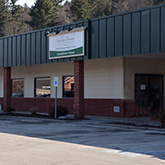At Central Vermont Medical Center our Physical Therapists provide individualized programs to treat pelvic or abdominal pain.
Physical therapy plays a major role in the diagnosis and treatment of pelvic pain and abdominal pain. These issues often arise post-partum, but can come on at any time and sometimes without obvious cause.
What are the pelvic floor muscles?
The pelvic floor muscles are the muscles that help hold the pelvic organs in place and they are literally the muscular floor of the pelvis. The pelvic organs are the bladder and bowel in men, and bladder, bowel and uterus in women. (Go to www.continence.org for more specific information.)
Common symptoms of pelvic pain often include one or a combination of the following:
- pain during or following sex
- painful urination, urinary hesitancy, urgency, and/or frequency
- abdominal and groin pain
- sacroiliac joint pain/instability
- constipation
- painful periods
- provoked or unprovoked vulvar, vaginal, clitoral, perineal or anal pain
- difficulty wearing jeans, pants, or underwear
- pain with sitting
- difficulty exercising
Evaluation by a Physical Therapist
The first visit usually includes an internal/external vaginal/rectal examination* or biofeedback (surface electromyography). The examination procedures are dependent on the physical therapist you are seeing. The examination will also include the portions of the typical physical therapy evaluation including leg and trunk strength, range of motion, and any special tests we might consider valuable.
About biofeedback
- Biofeedback is a way to assess how well you use your pelvic floor muscles.
- Biofeedback is performed with the use of a small vaginal or rectal sensor (depending on the issue). The sensor is about the size of a tampon. This is not always done with a patient with pelvic pain. The decision is made on an individual basis.
- Biofeedback tells us how well you can voluntarily contract your pelvic floor muscles as well as relax them. It is crucial we examine both phases of the contraction as a person can seemingly have “good” pelvic floor strength, but be unable to relax completely following the contraction. This type of movement pattern often leads to pain as well as bowel bladder leakage if left unchanged.
*Internal/external examination: This is similar to a gynecological exam, but is done digitally without the use of a speculum. The patient can decide to opt out of either of the more invasive treatments if these make them uncomfortable. There is also plenty of education and many exercises that can be given.
Ask to speak directly with the physical therapist you are scheduled with if you have any reservations. We would be happy to answer any lingering questions. You will always be in a private treatment room.
Physical Therapy Treatment
Treatment focuses on creating an individualized program to fit your specific needs. Interventions include manual therapy, body awareness training, relaxation exercises, therapeutic exercise focusing on stretching and strengthening when appropriate.
The following are specific ways a physical therapist can help treat pelvic floor issues:
- Patient Education
- Explain what the pelvic floor is and how it contributes to bowel, bladder and sexual health and wellbeing.
- Toileting postures to reduce the tendency to strain which feeds into the cycle of having an overactive pelvic floor
- Help you identify bladder irritants in your diet that can contribute to burning with urination, increased urge to urinate, and increased frequency of urination.
- Bladder/bowel Training
Pelvic floor muscle training to improve your ability to use your pelvic floor muscles voluntarily. If you were asked to bend your elbow or knee you would do so without thinking, but because we cannot see our pelvic floor muscles and they do not create movement at a joint it can be difficult to contract them. Part of our training sessions will be helping you regain a sense of how to do this. - Manual Therapy for Pain Reduction and Improved Movement
- Identify and treat tender muscles and tissues
- Work on reducing the sensitivity of those tissues by teaching you self-massage techniques to use at home.
- Therapeutic Exercise
Exercises chosen to address your specific issues.
- Typically with pelvic pain the pelvic floor muscles are overactive and the pelvic girdle muscles (hip and trunk muscles) are tight and you need to learn how to let them relax. Sometimes this is all that is needed.
- For others pelvic floor muscle strengthening is needed after relaxation training because they are still experiencing symptoms of sexual dysfunction or leaking urine.
- In this case once you have a good sense of how to voluntarily relax your pelvic floor muscles we move on to strengthening the pelvic floor to improve bladder/bowel control and sexual function.
Useful links for more information:
- National Association for Continence: http://www.nafc.org/home
- Australian Continence Society: The Facts http://www.continence.org.au/pages/the-facts.html
- Pelvic health solutions: http://pelvichealthsolutions.ca/for-the-patient/what-is-pelvic-floor-physiotherapy/
- Pelvic health and rehab: http://www.pelvicpainrehab.com/blog/
See Also Treatment for: Urinary/Fecal Incontinence and Constipation
 Physical Therapist
Physical Therapist Physical Therapist
Physical Therapist Physical Therapist
Physical Therapist

CVMC Rehabilitation Therapy - Berlin
Phone
Fax
802-371-5350
Hours
Monday:
CVMC Rehabilitation Therapy - Northfield
Phone
Fax
802-485-6116

